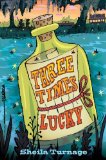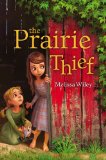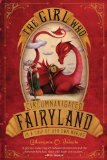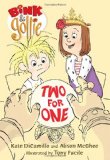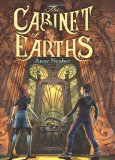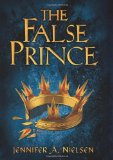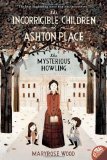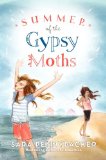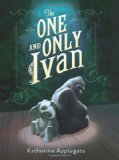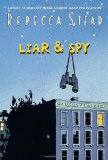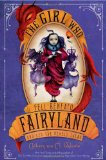 The Girl Who Fell Beneath Fairyland and Led the Revels There
The Girl Who Fell Beneath Fairyland and Led the Revels There
by Catherynne M. Valente
Feiwel and Friends, New York, 2012. 258 pages.
Starred Review
2012 Sonderbooks Stand-out: #9 Children’s Fiction: Fantasy and Science Fiction
The Girl Who Fell Beneath Fairyland and Led the Revels There is a sequel to The Girl Who Circumnavigated Fairyland in a Ship of Her Own Making. A friend of mine calls both of them The Girl With the Very Long Title. I think you can get away without having read the first book to read this one, because September’s adventures continue to be quite episodic, but she does meet many characters she met in her first set of adventures, or their shadows, so you may appreciate it more having read the first book.
It’s been a year since September saved Fairyland. She does miss it terribly, and the experience has made her all the more different from other girls at her school. And what no one seems to notice is that September left her shadow behind in Fairyland.
When September does get to go back, it turns out that her own shadow has gone to Fairyland-Below and become the Hollow Queen, Halloween. What’s more, she’s gradually draining more shadows from Fairyland-Above, and so people there are losing their magic along with their shadows. She meets A-Through-L, her dear wyverary, and her friend Saturday the marid, but they are actually the shadows of her friends and behave quite differently.
Now, I don’t know how much children will enjoy The Girl With the Very Long Title books. It would be a fun one to try out in a family read-aloud at bedtime. They would have to have high tolerance for big words. And the many things in the book that an adult finds funny and clever might not appeal as much to a child, because it is so funny precisely because it mirror’s a child’s logic.
There were many, many clever bits, and with my son away at college, I just have to share them in the review. I don’t think it gives away the plot at all, but shows the fun the author has with the situations.
A Wyvern’s body is different from the body of a young girl’s in several major respects. First, it has wings, which most young girls do not (there are exceptions). Second, it has a very long, thick tail, which some young girls may have, but those who find themselves so lucky keep them well hidden. Let us just say, there is a reason some ladies wore bustles in times gone by! Third, it weighs about as much as a tugboat carrying several horses and at least one boulder. There are girls who weigh that much, but as a rule, they are likely to be frost giants. Do not trouble such folk with asking after the time or why their shoes do not fit so well.
I loved the Physickists September met, students of Quiet Physicks, Queer Physicks, and Questing Physicks:
We seek out Quest-Dense Zones and hop in with both feet. We Experiment. We prove. Mersenne has gone off into the Jargoon Mountains to work on his thesis, investigating the spiritual connection between dragons and maidens. Candella last reported from the bottom of Blackdamp Lake, conducting experiments on free-range treasure. Red Newton wholly devoted himself to the study of magic apples, immortality causing and otherwise, and that means setting up a year-round camp in the Garden of Ascalaphus. . . . It is my dearest hope that one day I shall be the one to discover the GUT — the Grand Unified Tale, the one which will bind together all our Theorems and Laws, leaving out not one Orphan Girl or Youngest Son or Cup of Life and Death. Not one Descent or Ascent, not one Riddle or Puzzle or Trick. One perfect golden map that can guide any soul to its desire and back again.
Avogadra grinned. “Whilst on an expedition to prove the Rule of Three, my honored colleague Black Fermat hypothesized that certain Quest Objects cast a field around them, like a magnet or a planet — an Everyone Knows That Field. This is how they draw in unsuspecting Heroes. When an E.K.T. Field is in effect, everyone within its power will know a good deal about the Object, even if they can’t say where they heard about it or why it’s so deathly important to remember all that dusty old nonsense. They’ll chat about it with any passing stranger like it’s sizzling local gossip. ‘Oh, the Troll-Goblet of Clinkstone Hall? A Forgetful Whale swallowed it, and took it to her pod so they could bring the Whale-Maiden Omoom back to life. Everyone knows that! — the sword Excalibur? Nice lady down by the lake will let you see it for a dime, swing it for a dollar — Everyone knows that!’ Trust me, if you want to know the score, just find out What Everyone Knows, and you’ll be on the scent.
Later, September talks with a Mad Scientist:
A wyrmhole just goes from one place to another place. Dull as a street. A squidhole starts in one place — like my shop here — and goes five or ten other places, depending on how many field mice you happened to get.
And there are bits of wisdom:
For there are two kinds of forgiveness in the world: the one you practice because everything really is all right, and what went before is mended. The other kind of forgiveness you practice because someone needs desperately to be forgiven, or because you need just as badly to forgive them, for a heart can grab hold of old wounds and go sour as milk over them. You, being sharp and clever, will have noticed that I said “practice.” Forgiveness always takes practice to get right, and September was very new at it.
The story is episodic, with wild, random events happening to September one after the other, like a maze with unexpected turns. The author is incredibly imaginative, and I have to admit I enjoyed her little asides. I recommend trying the first book, and if you’re up for more of the same, you’ll definitely want to read on.
fairylandbook.com
mackids.com
Buy from Amazon.com
Find this review on Sonderbooks at: www.sonderbooks.com/Childrens_Fiction/girl_who_fell.html
Disclosure: I am an Amazon Affiliate, and will earn a small percentage if you order a book on Amazon after clicking through from my site.
Source: This review is based on an Advance Review Copy I got at an American Library Association conference.
Disclaimer: I am a professional librarian, but I write the posts for my website and blogs entirely on my own time. The views expressed are solely my own, and in no way represent the official views of my employer or of any committee or group of which I am part.
Please use the comments if you’ve read the book and want to discuss spoilers!
